In this article, we’ll discuss Nike’s standings and potential future through a PESTLE analysis. This framework will look at the Political, Economic, Social, Technological, Legal, and Environmental factors that affect the Nike organization. Did you know that before becoming Nike, the company was named Blue Ribbon Sports (BRS) when it was founded in 1964, and acted as a distributor for the Japanese shoemaker Onitsuka Tiger, which is now known as ASICS?
Nike, fully known as “Nike, Inc.”, is a US-based transnational corporation which provides trendy, functional sportswear across the globe. Nike serves to “bring inspiration and innovation to every athlete in the world.” [1]. Despite being one of the largest sport apparel and accessory companies in existence, Nike has to keep a high guard in its extremely competitive market. And in 2024, Nike has done so by launching the Air Max DN shoe, which we included in the technological factors below.
Nike: Political Factors
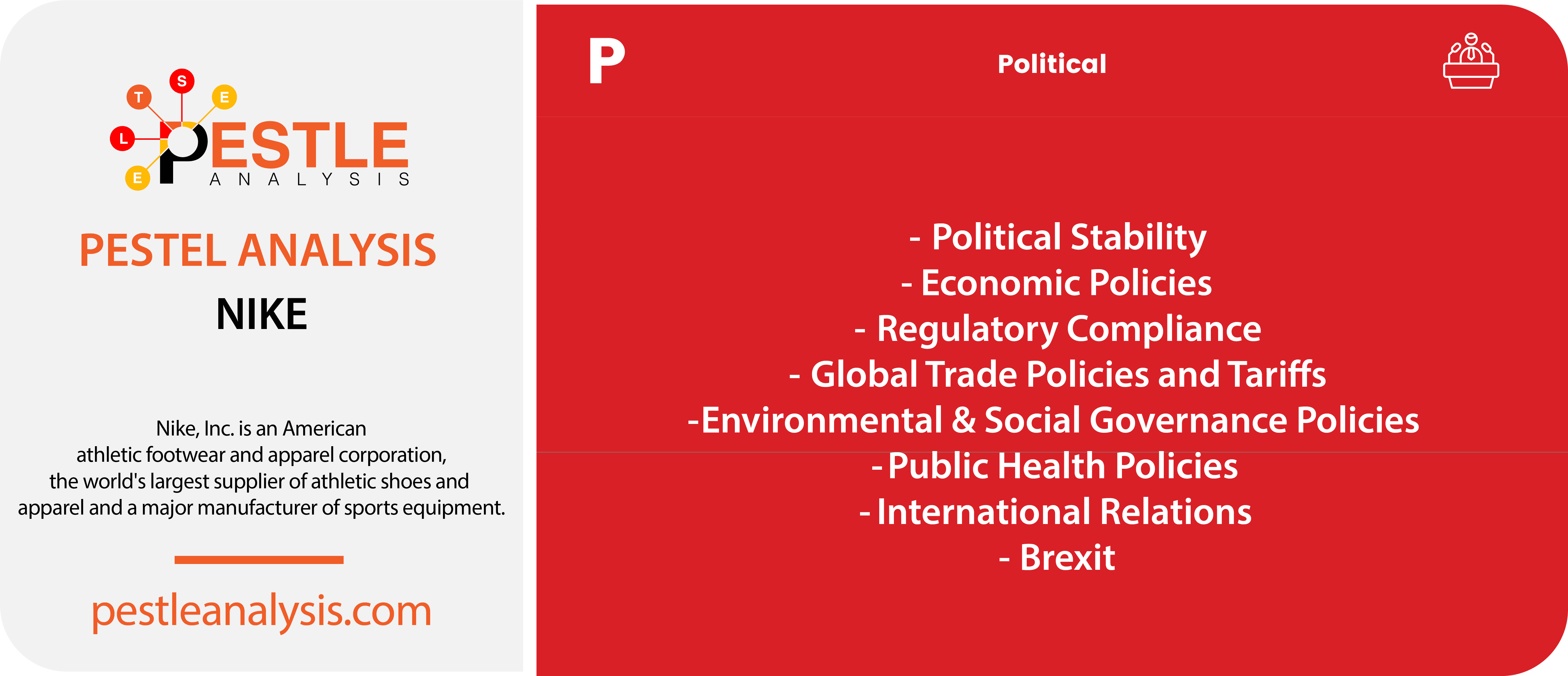
Did you know that Nike’s first official employee played a crucial role in the company’s early days, from selling shoes out of his van to suggesting the name "Nike," after the Greek goddess of victory?
Now that you know that it's time to look at the political factors in our PESTLE analysis of Nike
Political factors are especially important to the backend of a company -- the part we don’t normally see. Most of today’s political changes only affect how a company can produce their goods or how much profit they make, for example. To us, this may seem insignificant, but political factors decide the survivability of an organization. Here's how Nike and politics go hand in hand:
Political Stability and Economic Policies
United States, Nike’s ‘home country’ so to speak, has fantastic policies for growth which are especially valuable to this corporation. These include low-interest rates and well arranged international tax agreements.
Regulatory Compliance
As a company that produces and sells physical goods, Nike is, however, always subject to changes in tax and manufacturing laws. Political instability or changes in legislation can pose compliance risks, as Nike is a a multinational corporation.
Global Trade Policies and Tariffs
Various political conflicts can always make customs related processes difficult, or prevent imports and exports. For instance, the trade tensions between the U.S. and China can affect Nike's manufacturing costs and retail prices, as a significant portion of its production is based in China.
Environmental and Social Governance (ESG) Policies
There's a growing political and regulatory focus on sustainability and corporate social responsibility. Nike has invested in programs and partnerships aimed at encouraging physical activity among young people, like the NikeGo program that launched in 2005. [2]
Public Health Policies
The recent global pandemic highlighted the impact of public health policies on operations. Lockdowns, store closures, and restrictions on gatherings affected sales channels. For instance, in Q4 2020 Nike's revenue had a 38% decrease YoY but at the same time Nike's digital sales increased by 75%. Meanwhile, health and safety regulations impacted Nike's manufacturing process and distribution.
International Relations
The relationship between countries can affect Nike's operations. For example, geopolitical tensions can disrupt supply chains or alter market access. Positive diplomatic relations, on the other hand, might open up new opportunities. An example here was Nike CEO saying that Nike is a brand of China for China during the U.S.-China trade war.
Brexit
The UK's departure from the EU has implications for Nike in terms of changes in trade tariffs, labor mobility, and regulatory frameworks. Adjusting to these new conditions requires strategic planning and possibly restructuring operations in Europe. Back in 2021 Nike suspended their trainer recycling programme due to high costs related to Brexit. [3]
Nike: Economic Factors
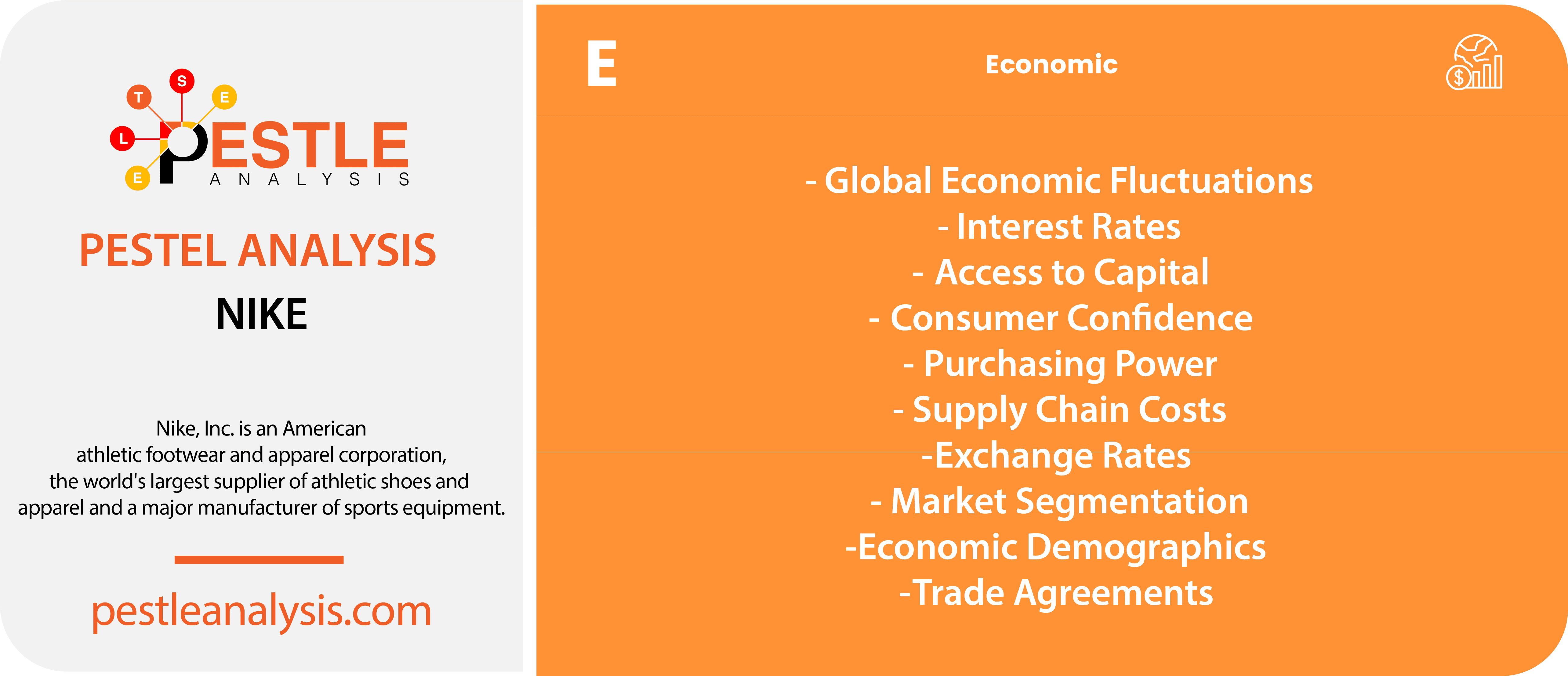
Did you know that the iconic Nike Swoosh logo was designed by a graphic design student who was paid only $35 for her design but as the company grew, she was given stock that is now worth over a million dollars?
Now that you know that it's time to look at the economic factors in our PESTLE analysis of Nike.
The latest financial statistics for Nike's business, as reported for the fiscal 2024 second quarter ending on November 30, 2023, are as follows:
- Second quarter revenues amounted to $13.4 billion, marking a 1 percent increase on a reported basis compared to the prior year, although there was a 1 percent decrease on a currency-neutral basis.
- Nike Direct revenues were $5.7 billion, up 6 percent on a reported basis and up 4 percent on a currency-neutral basis.
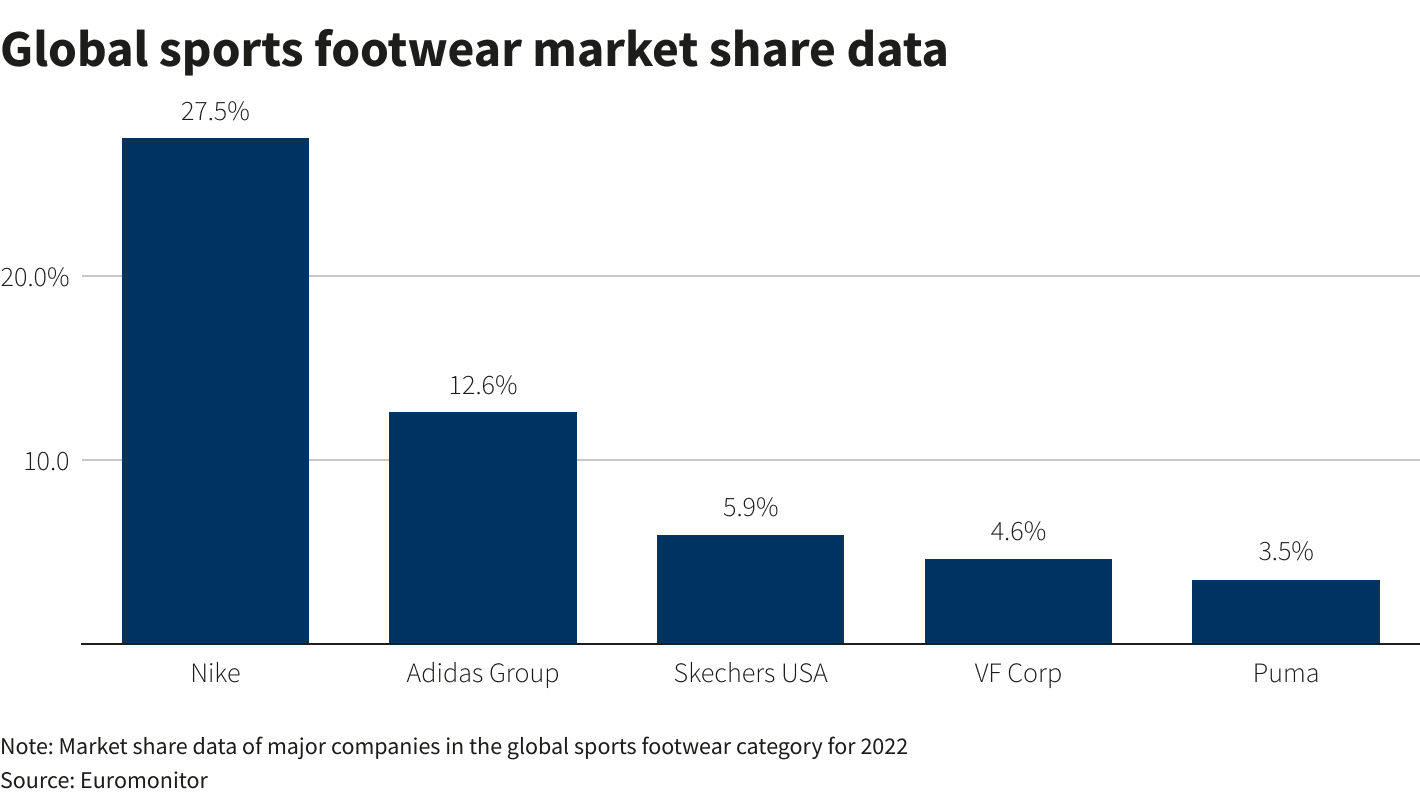
Nike sells a well-respected medium-range product, so they are less vulnerable to economic factors than others. Nevertheless here are some of the economic variables:
Global Economic Fluctuations
A market collapse could mean bad news for Nike, along with many other big brands. Consumers may choose to switch to lower-end, cheaper products if this were to occur, or even just as a decent level of quality becomes easier to produce.
Interest Rates and Access to Capital
With its ‘deep pocket’ of finances, Nike has the resources to chase after small emerging markets in which they could sell products.Nike’s revenues are to some extent dependent on the low cost of labour in Far Eastern countries. This is changing, though, which might mean higher Nike prices across the globe come with the development in Less Economically Developed Countries.
Consumer Confidence and Purchasing Power
The more confident consumers are of the economy, the more money they want to spend on Nike products. In countries that economy is growing, people are expected to spend more. On the contrary, in areas where consumers are afraid of their paychecks, sales may stagnate or decline.
Supply Chain Costs
I suppose making Nike shoes involves a lot of raw material processing and transportation. This surely will have an effect on production expenses. Rising costs can squeeze margins unless offset by price increases or operational efficiencies.
Exchange Rates
As a global company, Nike is exposed to currency risk.
Market Segmentation and Economic Demographics
Market trends and consumer demographics come to mind here. For instance, growing middle-class populations in emerging markets might seem as an opportunity for Nike to expand its customer base.
Competition and Market Share
Nike isn't alone in the game. Nike and its competitors, such as Adidas and Ralph Lauren, will fight for market share in a favorable economic climate where consumers are spending more money.
Economic Policies and Trade Agreements
When this paperwork promotes free trade Nike has easier access to the market. When it favors protectionist measures, those policies can pose challenges.
Nike: Social Factors
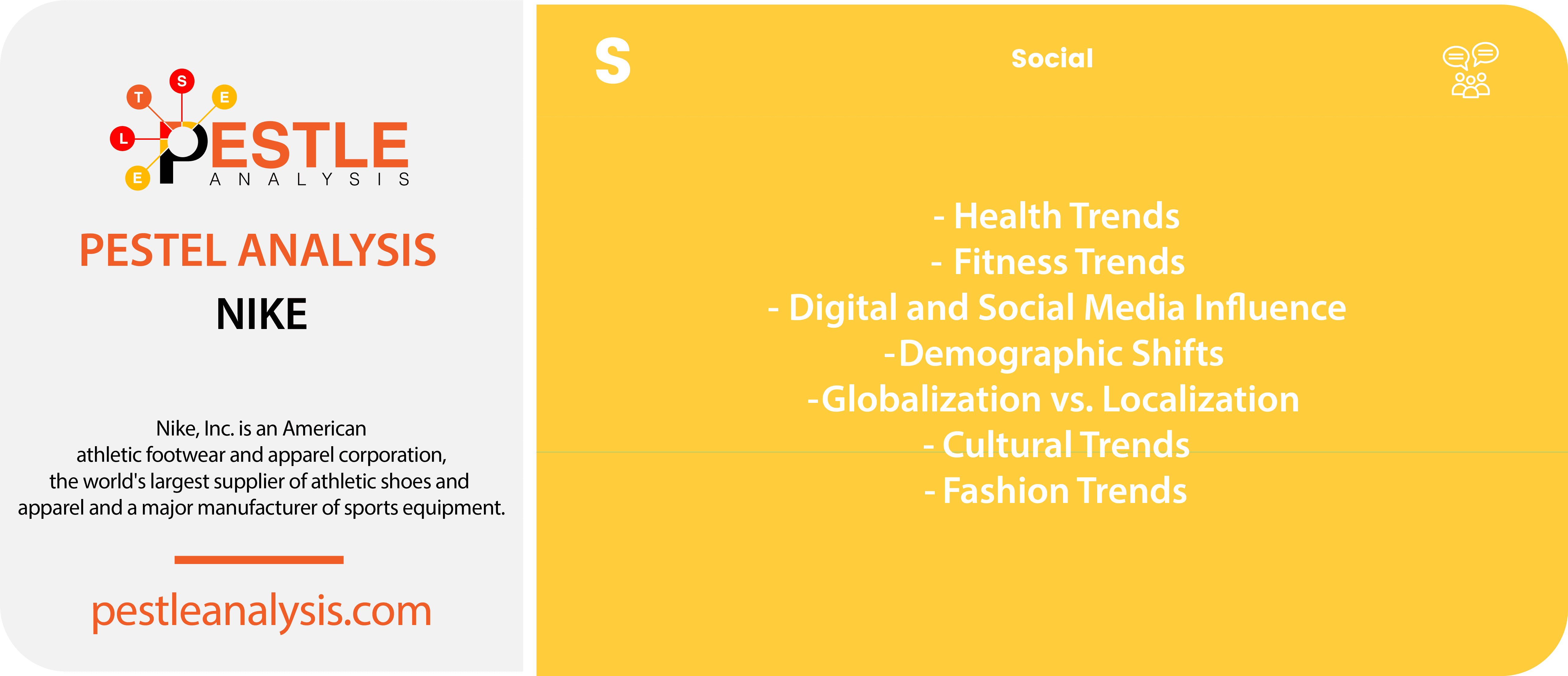
Did you know that the idea for Nike’s revolutionary waffle-tread running shoes came from co-founder Bill Bowerman’s experiments with his wife’s waffle iron and this innovation would significantly boost Nike’s reputation in the running community?
Now that you know that it's time to look at the social factors in our PESTLE analysis of Nike.
Public relations has never been more relevant than today. Social factors significantly influence Nike's brand positioning, marketing strategies, and product development. A good social status means a lot for modern corporations, so it’s definitely worth considering these factors:
Health and Fitness Trends
An increasing global emphasis on health, wellness, and fitness significantly benefits Nike. Worldwide increases in ‘health consciousness’ means that more and more individuals are moving towards better lifestyles. These people will undoubtedly buy plenty of sports apparel, something which would make Nike very happy.
Digital and Social Media Influence
The rise of digital platforms and social media has transformed consumer behaviors and marketing strategies. Social media allows things to blow up or whittle away faster than ever. Nike is doing well with using social media to build their brand, but it can be a double-edged sword if used incorrectly. Social media trends can also significantly influence brand perception and product popularity.
Demographic Shifts
Populations in developed countries are aging, whereas emerging markets enjoy young, growing populations. These should definitely affect Nike's target markets and product offerings.
Globalization vs. Localization
While Nike sells its products worldwide, offering a product influenced by local culture will likely lead to more locals trusting the brand.
Cultural and Fashion Trends
Let's not forget that sports and fashion are often mixed, with celebrities and athletes taking turns influencing both industries!
Nike Technological Factors

Did you know that a pair of those rare shoes Bill Bowerman created, named "Moon Show", sold at auction for $437,500 in 2019, setting a record for a pair of sneakers?
Now that you know that it's time to look at the technological factors in our PESTLE analysis of Nike.
Technological factors play a pivotal role in shaping Nike's business strategies and operational efficiencies. Technology gives companies the ability to innovate in so many different ways. From interacting with customers to designing products, technology provides value to organizations just like Nike. Here are some of the Technological factors affecting it:
Innovation in Product Design and Materials
New technologies can be used to improve Nike's product design or features. And that's what Nike did. Back in 2014 Nike combined 3D knitting with 3D printing in their Nike Vapor Ultimate Cleat American football boot [4]! And Nike isn't pausing innovation any time soon, as Nike launched the Air Max Dn on March 2024, redefining what it feels to walk on Air [5]!
Data Analytics and Consumer Insights
Big data analytics and Artificial Intelligence play a crucial role in understanding consumer preferences. Nike gets the opportunity to use valuable information based metrics thanks to these technological advances, allowing for them to optimize targeting and production, and maximize revenue.
Virtual and Augmented Reality (VR/AR)
VR and AR technologies offer Nike innovative ways to engage with consumers, from virtual product try-ons to immersive brand experiences. These technologies can enhance online shopping experiences and drive engagement in retail spaces.
Wearable Technology and Smart Products
The growing market for wearable technology, such as fitness trackers and smartwatches, presents an opportunity for Nike to integrate its products with digital health and fitness applications, enhancing the consumer's active lifestyle experience.

Nike: Legal Factors
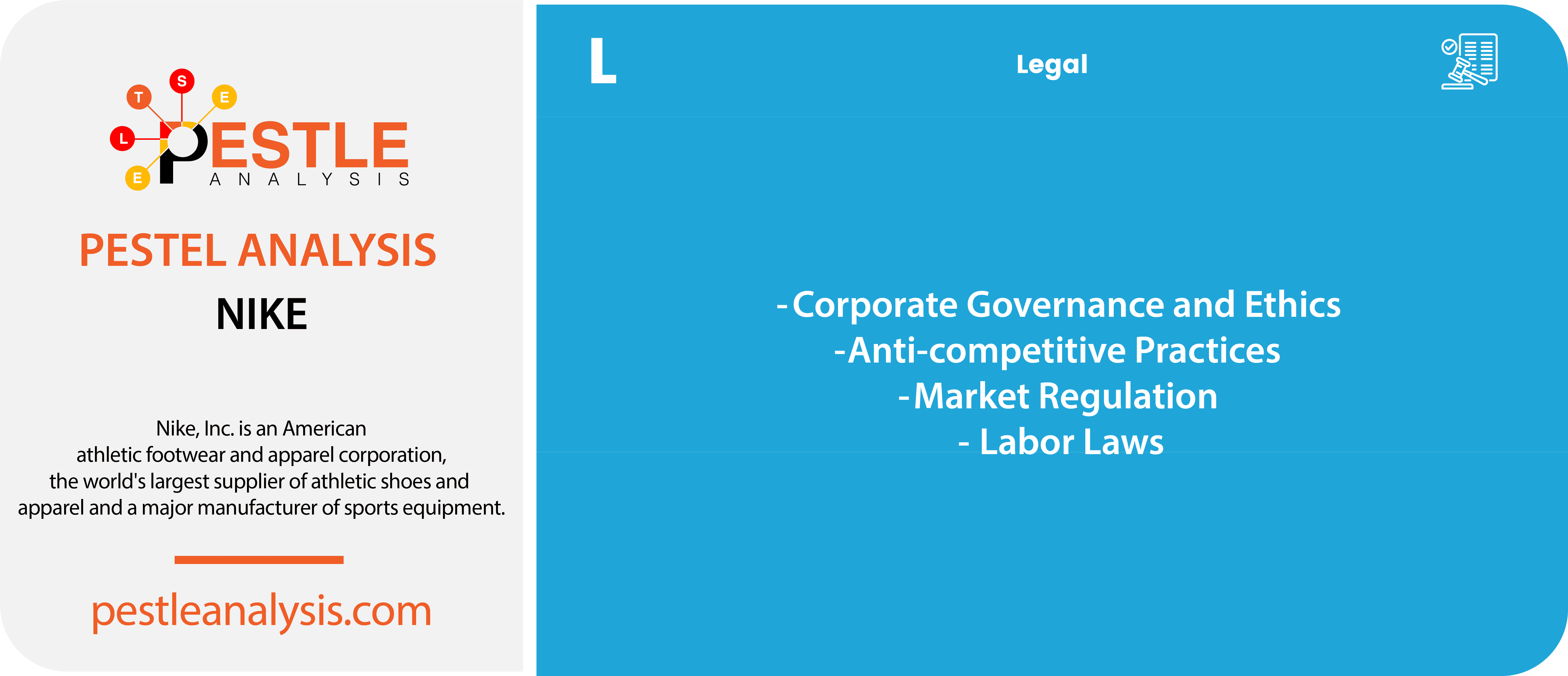
Did you know that Nike’s “Just Do It” slogan was inspired by the last words of Gary Gilmore, a notorious criminal who was executed in 1977?
Now that you know that it's time to look at the legal factors in our PESTLE analysis of Nike.
Legal factors are critical in shaping the operational, strategic, and ethical framework within which Nike operates. Legal factors are sometimes grouped together with political factors in a PEST analysis, but in a PESTLE analysis - which is what we’re doing - the two are separated. You may not think that there are many legal variables for Nike, but we haven’t forgotten about the elephant in the room. Here are some key legal factors affecting Nike:
Corporate Governance and Ethics
It shouldn’t surprise you to hear that, like most massive corporations, Nike also dodges substantial amounts of tax [6]. In recent years, there hasn’t been too much of a crackdown on this, but it’s still valuable to consider.
Anti-Competitive Practices and Market Regulation
Also, Nike occasionally meets legal repercussions for its shady marketing practices, which include false discounts [7].
Labor Laws and Practices
This includes fair labor practices, minimum wage regulations, working conditions, and child labor laws. In fact, the issue of Nike sweatshops is so prominent that it has warranted an entire Wikipedia article on the topic [8].
Nike: Environmental Factors

Did you know that Nike as a pioneer in using recycled materials for its products has developed innovative materials like Nike Grind, which is made from recycled athletic footwear and surplus manufacturing scraps?
Now that you know that it's time to look at the environmental factors in our PESTLE analysis of Nike to explore Nike's environmental impact and issues.
Environmental factors are of ever-growing importance and increasingly prominent in the strategic planning of global companies like Nike.
Climate Change and Operational Impact
Nike’s mass production factories are, without a doubt, harming the environment. Not only do they release plenty of aerial pollution like most factories, but Nike’s production centers occasionally go as far as directly polluting rivers [9].
Sustainability and Eco-Friendly Materials
However, Nike also shows promise of a change in their current practices, with a strong resolve to become more ‘eco’. There is a growing demand for sustainable and environmentally friendly products. Nike has responded by incorporating recycled materials into its products and aiming to reduce its carbon footprint. A known initiative is the Move to Zero campaign [10], which aims for zero carbon and zero waste.
Waste Reduction and Recycling
The issue of waste in the fashion industry is quite big. Programs like Nike's Reuse-A-Shoe program recycle old sneakers into sports surfaces.
Final Thoughts on PESTLE Analysis of Nike
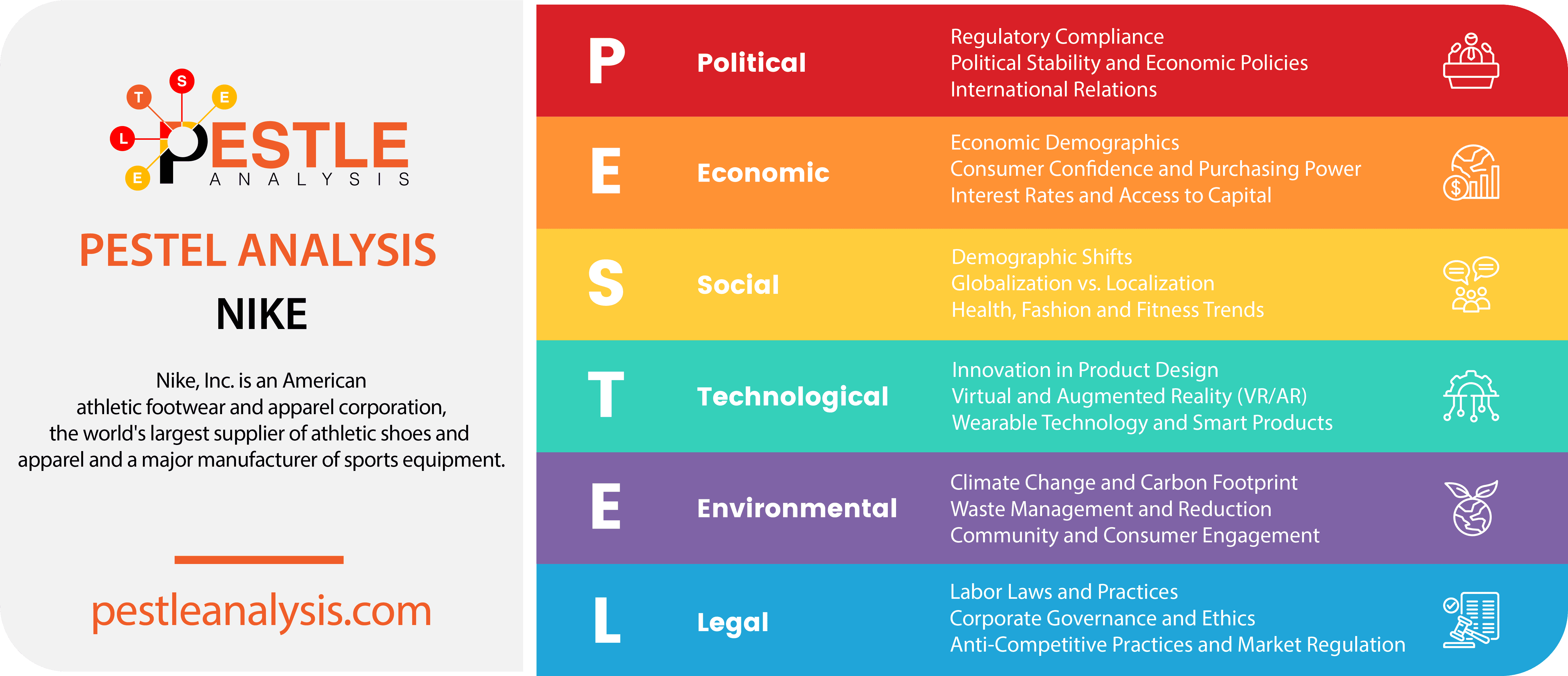
That’s a wrap for this PESTLE analysis of Nike. They may have a strong brand and healthy finances, but they need to pay careful attention to the morality of their practices and watch out for other growing, cheaper outlets.
Have we missed any other factors which might be relevant to Nike? Let us know! And in the meantime, check out Nike's strengths, weaknesses, opportunities and threats in our SWOT Analysis of Nike! Also, make sure to check out more PESTLE analysis examples and find out everything you need to know about PESTLE analysis here!
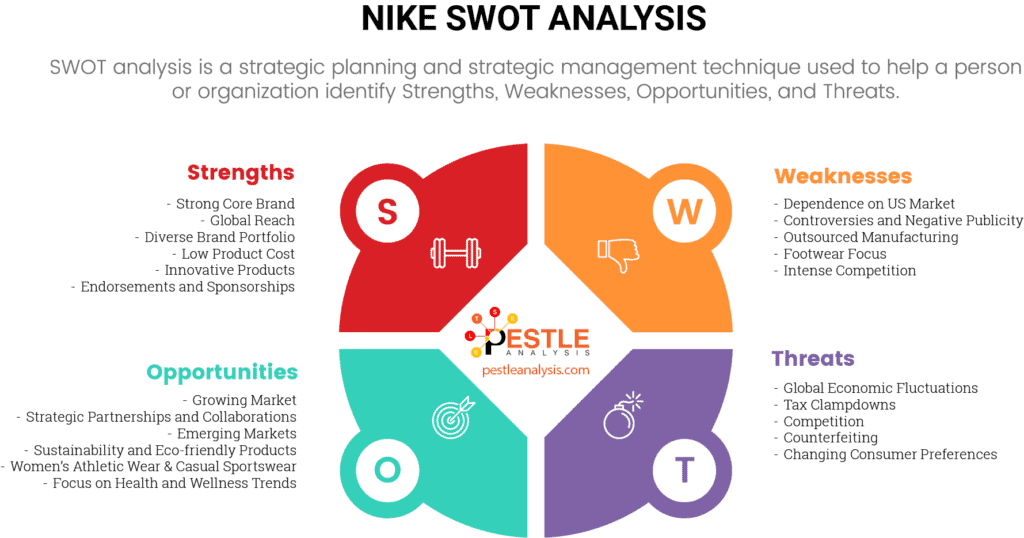
FAQ
- Is Nike made in China? Yes, Nike products are manufactured in China among other countries.
- What industry is Nike? Nike is in the sports apparel industry, and it is often mentioned that they are also in the fashion and retail industries.
- How many countries does Nike operate in? Nike operates globally in around 190 countries.
- How many countries are involved in creating Nike materials? Mixed reports online imply that about 600 factories are responsible for Nike products, but the number of locations varies from 40 to 46 countries.
- Who is the target market for Nike? While Nike targets athletes, professionals, and enthusiasts, its users range from 15 to 45 years old.
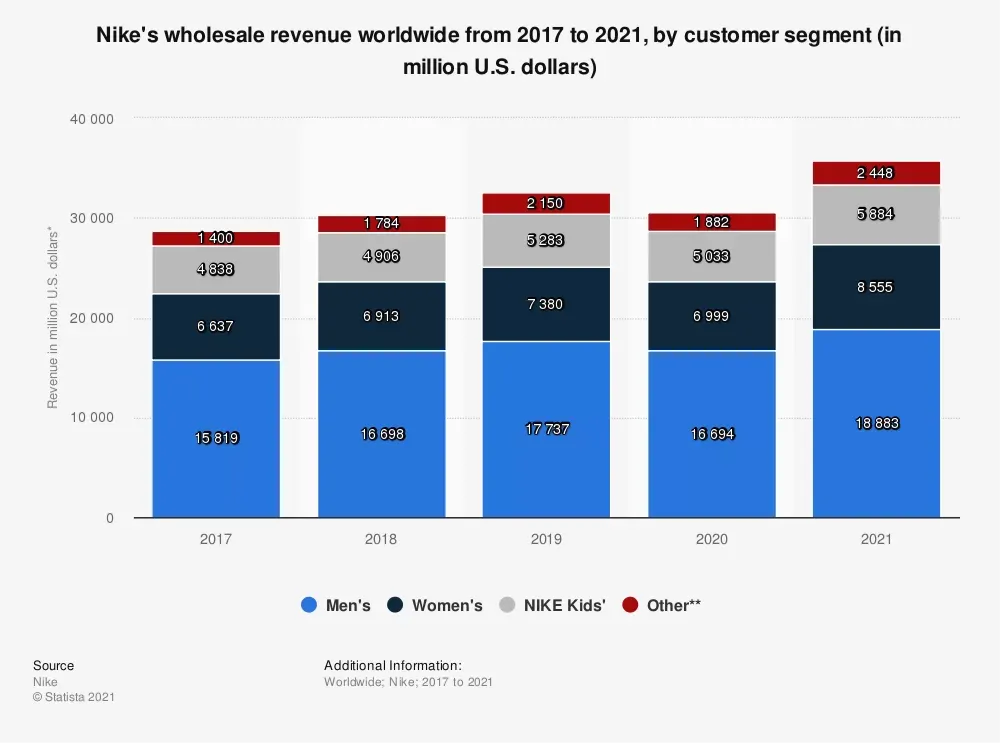
[1] http://help-en-us.nike.com/app/answers/detail/a_id/113/~/nike-mission-statement
[2] https://investors.nike.com/investors/news-events-and-reports/investor-news/investor-news-details/2005/NikeGO-and-the-National-Head-Start-Association-Launch-First-of-its-Kind-Physical-Activity-Program-for-Preschool-Children/default.aspx
[3] https://www.independent.co.uk/climate-change/sustainable-living/nike-trainers-recycling-programme-brexit-b1944302.html
[4] https://www.knittingindustry.com/nike-combines-3d-knitting-with-3d-printing-in-new-sports-footwear-range/
[5] https://www.nike.com/a/air-max-dn-release-info
[6] http://www.marketwatch.com/story/heres-how-apple-nike-and-others-avoided-620-billion-in-taxes-2015-10-06
[7] http://koin.com/2016/04/19/nike-faces-5-million-class-action-lawsuit/
[8] https://en.wikipedia.org/wiki/Nike_sweatshops
[9] http://phys.org/news/2011-07-nike-adidas-suppliers-polluting-china.html
[10] https://www.nike.com/sustainability







